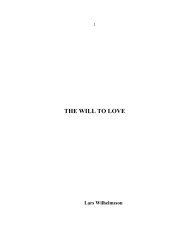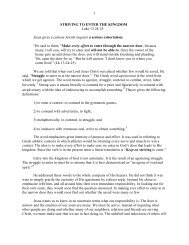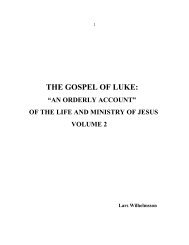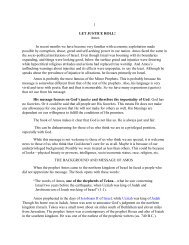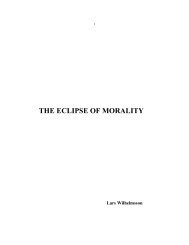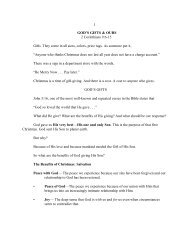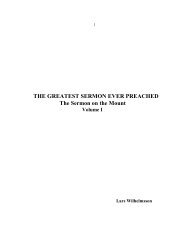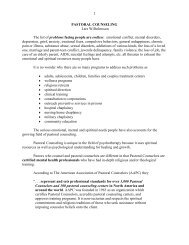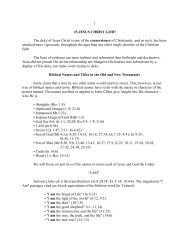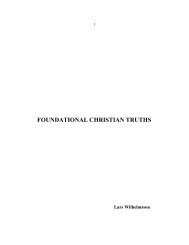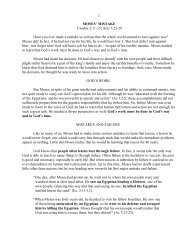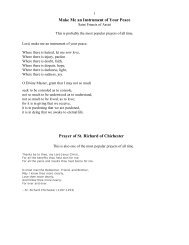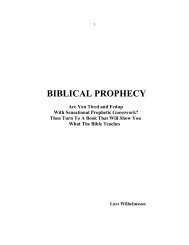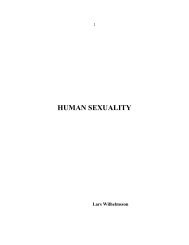- Page 1 and 2:
1 JESUS CHRIST: GOD-MAN Lars Wilhel
- Page 3 and 4:
3 PREFACE If we miss who Jesus is,
- Page 5 and 6:
5 INTRODUCTION
- Page 7 and 8:
There is a vicious battle going on
- Page 9 and 10:
9 Within a few centuries Jesus had
- Page 11 and 12:
11 I. THE RELIGIOUS LANDSCAPE
- Page 13 and 14:
ago: 13 Charles Haddon Spurgeon, th
- Page 15 and 16:
15 Here we see the extreme deceptiv
- Page 17 and 18:
17 Throughout history we have witne
- Page 19 and 20:
19 Although at first it may seem th
- Page 21 and 22:
21 MODERNITY German theologian Wolf
- Page 23 and 24:
23 THE CALL TO SEEK AND BATTLE FOR
- Page 25 and 26:
25 2. ORTHODOXY AND HERESY
- Page 27 and 28:
This anti-Christian influence was n
- Page 29 and 30:
29 The Apollinarians denied the int
- Page 31 and 32:
31 "And in one Lord Jesus Christ, t
- Page 33 and 34:
33 there are now two persons or two
- Page 35 and 36:
35 ● "They crucified the Lord of
- Page 37 and 38:
37 Although the Jehovah's Witnesses
- Page 39 and 40:
39 The Way International cult belie
- Page 41 and 42:
41 4. EXCLUSIVE SALVATION. Because
- Page 43 and 44:
The cultist takes pride in his lack
- Page 45 and 46:
Due to the obscurity of Judea in th
- Page 47 and 48:
"What advantage did the Jews gain f
- Page 49 and 50:
49 It is the opinion of Professor P
- Page 51 and 52:
51 4. THE ESSENCE OF ORTHODOX CHRIS
- Page 53 and 54:
53 No theologian in all of church h
- Page 55 and 56:
55 THE WITNESS OF THE HEBREW SCRIPT
- Page 57 and 58:
57 OTHER CREDENTIALS OF JESUS AS TH
- Page 59 and 60:
59 "The manuscript for Science Spea
- Page 61 and 62:
61 John further emphasizes how cruc
- Page 63 and 64:
63 humanity and is made on the basi
- Page 65 and 66:
65 "If Jesus Christ is only morally
- Page 67 and 68:
67 "I have been reading poems, roma
- Page 69 and 70:
69 For what I received I passed on
- Page 71 and 72:
71 INSPIRATION "The test of truth i
- Page 73 and 74:
73 This is called the "classical" v
- Page 75 and 76:
75 Verbal Inspiration Historically
- Page 77 and 78:
77 ". . . most disastrous consequen
- Page 79 and 80:
79 There is no denial that there ar
- Page 81 and 82:
81 Much of Old Testament historical
- Page 83 and 84:
83 Apocalyptic The books of Daniel
- Page 85 and 86:
85 Scripture is uniquely reliable b
- Page 87 and 88:
87 Moreover, they themselves were c
- Page 89 and 90:
"In regard to the Great Book I have
- Page 91 and 92:
91 Reliability or Accuracy of the B
- Page 93 and 94:
Sir Frederick Kenyon in his book Th
- Page 95 and 96:
95 contemporary history books. The
- Page 97 and 98:
97 The Number of New Testament Manu
- Page 99 and 100:
99 The following charts illustrate
- Page 101 and 102:
101 Testament which requires it to
- Page 103 and 104:
103 It is ironic that only 50 years
- Page 105 and 106:
105 While Barth may have overemphas
- Page 107 and 108:
107 How about the New Testament? Ho
- Page 109 and 110:
109 So-called "common copies" for p
- Page 111 and 112: 111 The New Testament First, the in
- Page 113 and 114: Although not all the writings of th
- Page 115 and 116: 115 The Easter letter ("Festal Lett
- Page 117 and 118: 117 Gordon Fee and Douglas Stuart p
- Page 119 and 120: 119 Hasty generalizations is a temp
- Page 121 and 122: 121 Later revelatory spokesmen also
- Page 123 and 124: 123 6. THE PREEXISTENCE OF JESUS TH
- Page 125 and 126: 125 The Greek word for "begotten" o
- Page 127 and 128: 127 THE PREINCARNATE CHRIST'S RELAT
- Page 129 and 130: 129 Old Testament: God heard—Ange
- Page 131 and 132: 131 Christ and Michael are the same
- Page 133 and 134: 133 THE INCARNATION OF CHRIST Incar
- Page 135 and 136: 135 REPEATEDLY CALLED "MAN" One of
- Page 137 and 138: The second line of the hymn states:
- Page 139 and 140: The first line of the hymn states:
- Page 141 and 142: 141 We Westerners are extremely imp
- Page 143 and 144: 143 One of the reasons we do not co
- Page 145 and 146: was 145 "The angel answered, 'The H
- Page 147 and 148: 147 8. THE HUMANITY OF JESUS CHRIST
- Page 149 and 150: 149 To the two discouraged disciple
- Page 151 and 152: 151 Jesus is repeatedly called and
- Page 153 and 154: 153 It is because of His complete d
- Page 155 and 156: 155 ● "The Jesus, still teaching
- Page 157 and 158: 157 Jurgen Moltmann in his book, Th
- Page 159 and 160: 159 "The firstborn one from the dea
- Page 161: 161 Like the Jehovah's Witnesses, t
- Page 165 and 166: 165 even Moses showed that the dead
- Page 167 and 168: 167 In His incarnation, Jesus came
- Page 169 and 170: 169 The writer proceeds by saying t
- Page 171 and 172: 171 Evidence for the Deity of Jesus
- Page 173 and 174: 173 ● Master (Mt 8:19) ● Mediat
- Page 175 and 176: 175 ● He is Omnipresent (everywhe
- Page 177 and 178: 177 granted the Son to have life in
- Page 179 and 180: 179 "God exalted . . . to His own r
- Page 181 and 182: 181 10. THE DEITY OF JESUS CHRIST P
- Page 183 and 184: 183 ● It is "by faith in the Son
- Page 185 and 186: 185 "They all asked, 'Are you then
- Page 187 and 188: 187 ● He is called "Immanuel" (Is
- Page 189 and 190: 189 ● He is called "Lord" (Lk 2:1
- Page 191 and 192: 191 Jehovah's Witnesses make the fu
- Page 193 and 194: 193 The grammatical construction he
- Page 195 and 196: 195 "So too John 1:1 uses O THEOS t
- Page 197 and 198: 197 ● ". . . how much more will t
- Page 199 and 200: 199 John could have said, "The Word
- Page 201 and 202: 201 Russell, Barbour, Wilson, Franz
- Page 203 and 204: 203 11. THE DEITY OF JESUS CHRIST P
- Page 205 and 206: 205 In the same spirit are those me
- Page 207 and 208: 207 What audacity! Who but God coul
- Page 209 and 210: 209 Christ, as the divine Wisdom, i
- Page 211 and 212: 211 Jesus is the radiance or reflec
- Page 213 and 214:
213 On the following page is listed
- Page 215 and 216:
215 "Your attitude should be the sa
- Page 217 and 218:
217 Divine Worship is Rendered and
- Page 219 and 220:
219 12. THE DEITY OF JESUS CHRIST P
- Page 221 and 222:
221 "If we let Him go on like this,
- Page 223 and 224:
223 Jesus was accused of being ment
- Page 225 and 226:
225 "This is My Son, whom I love; w
- Page 227 and 228:
227 ● To receive Him was to recei
- Page 229 and 230:
229 Jesus' teaching, whether it was
- Page 231 and 232:
No harsher words are found in Holy
- Page 233 and 234:
Here Jesus is called the personific
- Page 235 and 236:
235 It should be kept in mind that
- Page 237 and 238:
237 There are several texts which t
- Page 239 and 240:
239 Jesus also speaks to His discip
- Page 241 and 242:
241 By their actions these judges h
- Page 243 and 244:
243 15. THE DEITY OF JESUS CHRIST P
- Page 245 and 246:
245 In revealing His omniscience to
- Page 247 and 248:
247 The New World Translation of th
- Page 249 and 250:
249 Jesus is also appropriately cal
- Page 251 and 252:
251 Jehovah God and God the Son are
- Page 253 and 254:
253 How could Jehovah and Jesus Chr
- Page 255 and 256:
255 With the complete knowledge tha
- Page 257 and 258:
257 16. THE RESURRECTION OF JESUS C
- Page 259 and 260:
259 The resurrection of Jesus of Na
- Page 261 and 262:
261 4. The Corinthians are still in
- Page 263 and 264:
263 NATURE OF RESURRECTION The natu
- Page 265 and 266:
265 THE RESULTS OF THE RESURRECTION
- Page 267 and 268:
267 can give credible evidence as t
- Page 269 and 270:
269 being so tall that He towers ab
- Page 271 and 272:
271 "In light of these facts, the G
- Page 273 and 274:
273 "Men of Israel, listen to this:
- Page 275 and 276:
275 Testimony of People through the
- Page 277 and 278:
277 His skeptical disciples (they d
- Page 279 and 280:
279 The Presence of Women The menti
- Page 281 and 282:
The first converts accepted his wor
- Page 283 and 284:
283 Legal Experts Simon Greenleaf,
- Page 285 and 286:
285 "My faith began with and was gr
- Page 287 and 288:
287 17. ONLY SIX OPTIONS: THE CHALL
- Page 289 and 290:
289 "All the essentials of Hinduism
- Page 291 and 292:
291 This makes perfect sense since
- Page 293 and 294:
293 LUNATIC Another possibility con
- Page 295 and 296:
295 Could a demented person produce
- Page 297 and 298:
297 Virgil, the Roman poet, warned
- Page 299 and 300:
299 As we have repeatedly seen, Jes
- Page 301 and 302:
301 As we end our journey of examin
- Page 303 and 304:
71. 303 11 Wolfhart Pannenberg, Jes
- Page 305 and 306:
142. 305 6 Ibid., 233. 7 Ibid. 8 Gr
- Page 307 and 308:
26 Ibid. See also Marshall, “Our
- Page 309 and 310:
309 30 Ibid. 31 Sir William Ramsey,
- Page 311 and 312:
311 66 Ibid. 67 Ibid. 68 Meye, “C
- Page 313 and 314:
313 5 France, The Evidence for Jesu
- Page 315 and 316:
315 15 “The Problem with “The N
- Page 317 and 318:
317 4 A Walk of Faith http://bwebbj
- Page 319 and 320:
319 17 Ibid. 18 Ibid., 173. 19 Ladd
- Page 321 and 322:
4 Philip Schaff, The Person of Chri
- Page 323 and 324:
323 21 Thinkexist.com “Quotes abo
- Page 325 and 326:
325 Carnell, E. J. An Introduction
- Page 327 and 328:
327 Ladd, George Eldon. "Kingdom of
- Page 329 and 330:
329 Stoner, Peter. Science Speaks:
- Page 331 and 332:
331 Lapide, Pinchas and Ulrich Luz.
- Page 333:
Neusner, Jacob. Messiah in Context:



